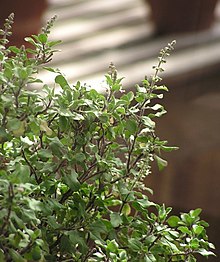Ocimum tenuiflorum
| Ocimum tenuiflorum | |
|---|---|
 |
|
| Scientific classification | |
| Kingdom: | Plantae |
| (unranked): | Angiosperms |
| (unranked): | Eudicots |
| (unranked): | Asterids |
| Order: | Lamiales |
| Family: | Lamiaceae |
| Genus: | Ocimum |
| Species: | O. tenuiflorum |
| Binomial name | |
|
Ocimum tenuiflorum L. |
|
| Synonyms | |
|
|
Ocimum tenuiflorum (synonym Ocimum sanctum), commonly known as holy basil, tulasi (sometimes spelled thulasi) or tulsi, is an aromatic plant in the family Lamiaceae which is native to the Indian subcontinent and widespread as a cultivated plant throughout the Southeast Asian tropics.
Tulasi is cultivated for religious and medicinal purposes, and for its essential oil. It is widely known across the Indian subcontinent as a medicinal plant and a herbal tea, commonly used in Ayurveda, and has an important role within the Vaishnava tradition of Hinduism, in which devotees perform worship involving holy basil plants or leaves. This plant is revered as an elixir of life.
The variety of Ocimum tenuiflorum used in Thai cuisine is referred to as Thai holy basil (Thai: กะเพรา kaphrao); it is not to be confused with Thai basil, which is a variety of Ocimum basilicum.
Holy basil is an erect, many-branched subshrub, 30–60 cm (12–24 in) tall with hairy stems. Leaves are green or purple; they are simple, petioled, with an , up to 5 cm (2.0 in)-long blade which usually has a slightly toothed margin; they are strongly scented and have a decussate phyllotaxy. The purplish flowers are placed in close whorls on elongate racemes . The two main morphotypes cultivated in India and Nepal are green-leaved (Sri or Lakshmi tulasi) and purple-leaved (Krishna tulasi).
...
Wikipedia
